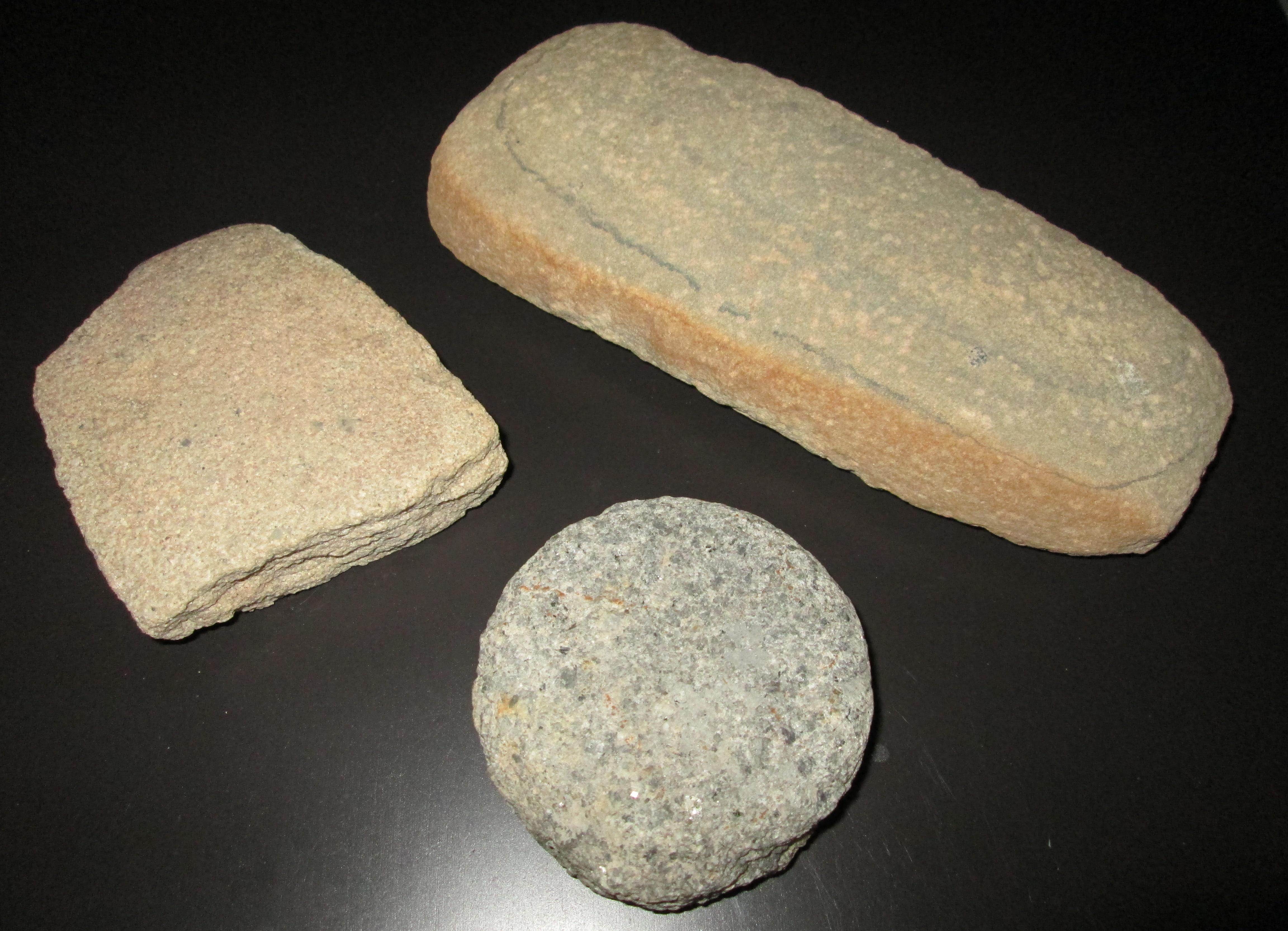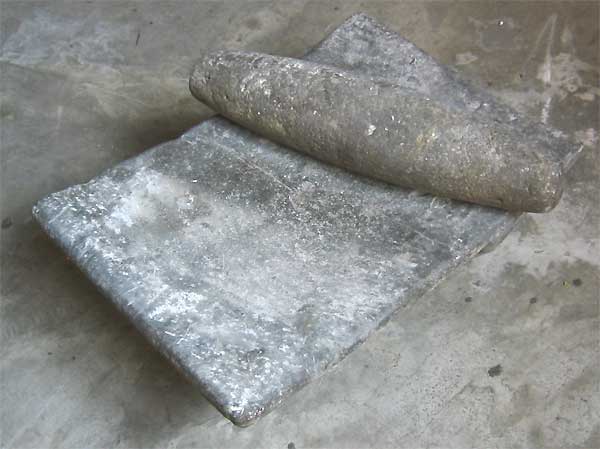Mano (stone) on:
[Wikipedia]
[Google]
[Amazon]
 A mano ( Spanish for ''hand'') is a ground stone tool used with a metate to process or grind food by hand.
It is also known by the
A mano ( Spanish for ''hand'') is a ground stone tool used with a metate to process or grind food by hand.
It is also known by the
''Archaeology of Prehistoric Native America: An Encyclopedia''.
pp. 107, 166. . In its early use in the American Southwest, the mano and metate were used to grind wild plants. The mano began as a one-handed tool. Once the maize cultivation became more prevalent, the mano became a larger, two-handed tool that more efficiently ground food against an evolved basin or trough metate. Besides food, Manos and metates were used to separate and pulverize
 A Mano, a smooth hand-held stone, is used against a metate, typically a large stone with a depression or bowl. The movement of the Mano against the metate consists of a circular, rocking or chopping grinding motion using one or both hands.
Ancient Pueblo People often set up work rooms, called mealing rooms, that were established with sets of manos and metates for mass grinding efforts. Plog, Stephen. (1997). ''Ancient Peoples of the American Southwest.'' London: Thames and Hudson. p. 80. .
A Mano, a smooth hand-held stone, is used against a metate, typically a large stone with a depression or bowl. The movement of the Mano against the metate consists of a circular, rocking or chopping grinding motion using one or both hands.
Ancient Pueblo People often set up work rooms, called mealing rooms, that were established with sets of manos and metates for mass grinding efforts. Plog, Stephen. (1997). ''Ancient Peoples of the American Southwest.'' London: Thames and Hudson. p. 80. .
Objects: Reluctant Witnesses to the Past
* Morris, Donald H. (Summer 1990). "Changes in Groundstone following the introduction of maize into the American Southwest." ''Journal of Anthropological Research.'' 46(2).
{{Prehistoric technology Food grinding tools Lithics Mesoamerican artifacts Mesoamerican cuisine Mexican food preparation utensils Indigenous tools of the Americas Native American cuisine Science and technology in Mesoamerica Stone objects
 A mano ( Spanish for ''hand'') is a ground stone tool used with a metate to process or grind food by hand.
It is also known by the
A mano ( Spanish for ''hand'') is a ground stone tool used with a metate to process or grind food by hand.
It is also known by the Nahuatl
Nahuatl (; ), Aztec, or Mexicano is a language or, by some definitions, a group of languages of the Uto-Aztecan language family. Varieties of Nahuatl are spoken by about Nahua peoples, most of whom live mainly in Central Mexico and have small ...
term metlapil.
History
Manos were used inprehistoric
Prehistory, also known as pre-literary history, is the period of human history between the use of the first stone tools by hominins 3.3 million years ago and the beginning of recorded history with the invention of writing systems. The us ...
times to process wild seeds, nuts, and other food, generally used with greater frequency in the Archaic period, when people became more reliant upon local wild plant food for their diet. Later, Manos and metates were used to process cultivated maize
Maize ( ; ''Zea mays'' subsp. ''mays'', from es, maíz after tnq, mahiz), also known as corn (North American English, North American and Australian English), is a cereal grain first domesticated by indigenous peoples of Mexico, indigenous ...
.Gibbon, Guy E.; Ames, Kenneth M. (1998''Archaeology of Prehistoric Native America: An Encyclopedia''.
pp. 107, 166. . In its early use in the American Southwest, the mano and metate were used to grind wild plants. The mano began as a one-handed tool. Once the maize cultivation became more prevalent, the mano became a larger, two-handed tool that more efficiently ground food against an evolved basin or trough metate. Besides food, Manos and metates were used to separate and pulverize
clay
Clay is a type of fine-grained natural soil material containing clay minerals (hydrous aluminium phyllosilicates, e.g. kaolin, Al2 Si2 O5( OH)4).
Clays develop plasticity when wet, due to a molecular film of water surrounding the clay pa ...
from earthen debris and stones. The resulting clay was used for pottery
Pottery is the process and the products of forming vessels and other objects with clay and other ceramic materials, which are fired at high temperatures to give them a hard and durable form. Major types include earthenware, stoneware and ...
-making.
Grinding process
 A Mano, a smooth hand-held stone, is used against a metate, typically a large stone with a depression or bowl. The movement of the Mano against the metate consists of a circular, rocking or chopping grinding motion using one or both hands.
Ancient Pueblo People often set up work rooms, called mealing rooms, that were established with sets of manos and metates for mass grinding efforts. Plog, Stephen. (1997). ''Ancient Peoples of the American Southwest.'' London: Thames and Hudson. p. 80. .
A Mano, a smooth hand-held stone, is used against a metate, typically a large stone with a depression or bowl. The movement of the Mano against the metate consists of a circular, rocking or chopping grinding motion using one or both hands.
Ancient Pueblo People often set up work rooms, called mealing rooms, that were established with sets of manos and metates for mass grinding efforts. Plog, Stephen. (1997). ''Ancient Peoples of the American Southwest.'' London: Thames and Hudson. p. 80. .
See also
* Bedrock metate * Grinding slab *Quern-stone
Quern-stones are stone tools for hand- grinding a wide variety of materials. They are used in pairs. The lower stationary stone of early examples is called a saddle quern, while the upper mobile stone is called a muller, rubber or handstone. The ...
References
Further reading
* Caple, ChrisObjects: Reluctant Witnesses to the Past
* Morris, Donald H. (Summer 1990). "Changes in Groundstone following the introduction of maize into the American Southwest." ''Journal of Anthropological Research.'' 46(2).
External links
{{Prehistoric technology Food grinding tools Lithics Mesoamerican artifacts Mesoamerican cuisine Mexican food preparation utensils Indigenous tools of the Americas Native American cuisine Science and technology in Mesoamerica Stone objects